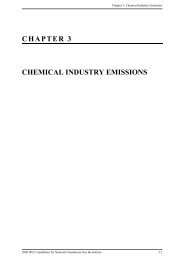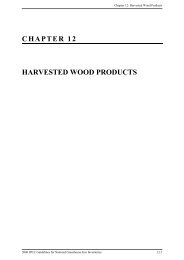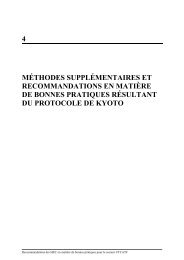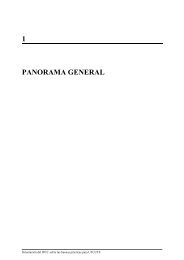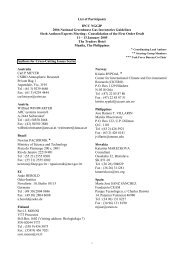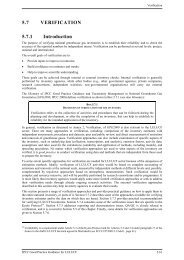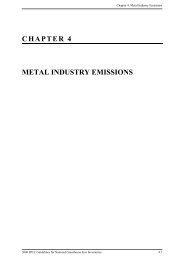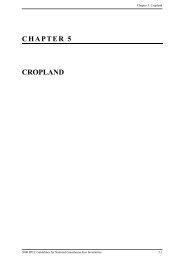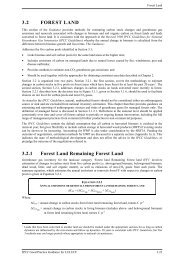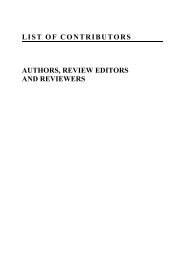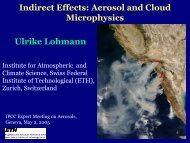Use of Models and Facility-Level Data in Greenhouse Gas Inventories
Use of Models and Facility-Level Data in Greenhouse Gas Inventories
Use of Models and Facility-Level Data in Greenhouse Gas Inventories
Create successful ePaper yourself
Turn your PDF publications into a flip-book with our unique Google optimized e-Paper software.
<strong>Use</strong> <strong>of</strong> <strong>Models</strong> <strong>and</strong> <strong>Facility</strong>-<strong>Level</strong> <strong>Data</strong> <strong>in</strong> <strong>Greenhouse</strong> <strong>Gas</strong> <strong>Inventories</strong><br />
Abstract<br />
Advanced (Tier 3) computer simulation models are <strong>in</strong>creas<strong>in</strong>gly used to estimate greenhouse gas emissions <strong>and</strong><br />
removals <strong>in</strong> managed forests. Some <strong>of</strong> these model use country-specific data on forest <strong>in</strong>ventory conditions, detailed<br />
activity data <strong>and</strong> process modell<strong>in</strong>g approaches to l<strong>in</strong>k dead organic matter <strong>and</strong> soil carbon pool dynamics to those <strong>of</strong><br />
biomass carbon pools. These Tier 3 models are expected to provide emissions <strong>and</strong> removals estimates <strong>of</strong> greater<br />
certa<strong>in</strong>ty than lower Tier methods. Here we briefly discuss the benefits <strong>of</strong> us<strong>in</strong>g Tier 3 models over simpler Tier 1 or 2<br />
approaches, summarise approaches to evaluat<strong>in</strong>g such models, <strong>and</strong> propose an activity that could contribute to<br />
<strong>in</strong>creas<strong>in</strong>g the transparency <strong>of</strong> Tier 3 models. Increased transparency is required to facilitate the review <strong>of</strong> greenhouse<br />
gas <strong>in</strong>ventories by expert review teams. In addition to improved documentation <strong>and</strong> the report<strong>in</strong>g <strong>of</strong> more detailed<br />
results us<strong>in</strong>g agreed-upon templates <strong>and</strong> <strong>in</strong>dicators, we outl<strong>in</strong>e an approach that would <strong>in</strong>volve a series <strong>of</strong> st<strong>and</strong>ardised<br />
tests <strong>and</strong> scenario analyses advanc<strong>in</strong>g from s<strong>in</strong>gle st<strong>and</strong>s to l<strong>and</strong>scapes <strong>of</strong> <strong>in</strong>creas<strong>in</strong>g complexity. Indicators <strong>and</strong><br />
performance criteria are proposed for consideration <strong>in</strong> these comparative tests. A future workshop <strong>in</strong>volv<strong>in</strong>g model<br />
developers, model users, <strong>in</strong>ventory compilers, <strong>and</strong> UNFCCC expert reviewers could focus on possible approaches to<br />
develop<strong>in</strong>g <strong>and</strong> implement<strong>in</strong>g such test<strong>in</strong>g protocols <strong>and</strong> the report<strong>in</strong>g <strong>of</strong> their results.<br />
Background<br />
The purpose <strong>of</strong> this paper is to advance discussion on a few issues explored <strong>in</strong> recent expert meet<strong>in</strong>gs <strong>of</strong> the IPCC <strong>and</strong><br />
UNFCCC. Although not the focus <strong>of</strong> those meet<strong>in</strong>gs, questions arose about the benefits <strong>of</strong> us<strong>in</strong>g Tier 3 models, <strong>in</strong>stead<br />
<strong>of</strong> Tier 1 or 2 approaches, to estimate greenhouse gas emissions <strong>and</strong> removals <strong>in</strong> managed forests. Discussions also<br />
addressed how these more complex models can be validated <strong>and</strong> made more transparent to expert reviewers.<br />
The paper explores three questions:<br />
1) What are the benefits <strong>of</strong> us<strong>in</strong>g Tier 3 models for the estimation <strong>of</strong> greenhouse gas emissions <strong>and</strong> removals <strong>in</strong><br />
managed forests?<br />
2) How can such Tier 3 models be evaluated?<br />
3) How can such Tier 3 models be made more transparent to reviewers?<br />
This paper is neither a comprehensive review nor an <strong>in</strong>-depth exploration <strong>of</strong> the issues. Instead, it is an attempt to share<br />
experiences <strong>and</strong> knowledge ga<strong>in</strong>ed dur<strong>in</strong>g the development <strong>and</strong> implementation <strong>of</strong> a Tier 3 model <strong>of</strong> forest carbon<br />
dynamics <strong>and</strong> greenhouse gas budgets. It also advances a proposal for a possible approach to <strong>in</strong>creas<strong>in</strong>g the<br />
transparency <strong>of</strong> Tier 3 models <strong>of</strong> forest carbon dynamics. The paper does not discuss Tier 3 measurement approaches.<br />
The development <strong>of</strong> a forest carbon dynamics model for Canada commenced <strong>in</strong> late 1989 (Kurz et al. 1992), long before<br />
the UNFCCC was signed <strong>in</strong> 1992. The purpose <strong>of</strong> the research tool was to quantify the contribution <strong>of</strong> Canada’s forests<br />
to the global carbon cycle. Over the past 20 years, the Carbon Budget Model <strong>of</strong> the Canadian Forest Sector (CBM-<br />
CFS3) has evolved to the third version (Kurz et al. 2009, Kull et al. 2006). It is the core model <strong>of</strong> Canada’s National<br />
Forest Carbon Monitor<strong>in</strong>g, Account<strong>in</strong>g <strong>and</strong> Report<strong>in</strong>g System (Kurz <strong>and</strong> Apps 2006). The model is used <strong>in</strong> Canada at<br />
various spatial scales (e.g., Dymond et al. 2010; Hagemann et al. 2010; Neilson et al. 2007; Taylor et al. 2008) <strong>and</strong> <strong>in</strong><br />
several countries around the world (e.g., Zamolodchikov et al. 2008).<br />
CBM-CFS3 is a comprehensive book-keep<strong>in</strong>g tool that relies heavily on forest <strong>in</strong>ventory data <strong>and</strong> comb<strong>in</strong>es these with<br />
<strong>in</strong>formation on processes that affect forest dynamics (activity data on natural disturbances, forest management <strong>and</strong> l<strong>and</strong>use<br />
change) to estimate annual greenhouse gas emissions <strong>and</strong> removals. Process simulations are used where<br />
<strong>in</strong>ventory data are limited, for example to represent the dynamics <strong>of</strong> dead organic matter <strong>and</strong> soil carbon pools. The<br />
model can be used to monitor past changes <strong>in</strong> carbon stocks (e.g. Tr<strong>of</strong>ymow et al. 2008, Bernier et al. 2010), us<strong>in</strong>g<br />
activity data <strong>of</strong> past events, or to simulate future changes (Kurz et al. 2008 a,b; Metsaranta et al. 2010), us<strong>in</strong>g scenario<br />
projections <strong>of</strong> future events such as natural disturbances, forest management or l<strong>and</strong>-use changes.<br />
IPCC Expert Meet<strong>in</strong>g Report 40 TFI




